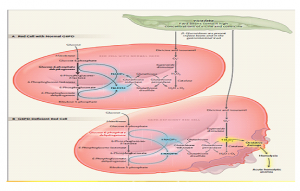م. م. أحمد عبد الأمير حسين
كلية الزراعة / جامعة كربلاء
Favism disease: It is a term indicating the occurrence of acute lytic anemia after ingestion of pests or when inhaling pollen dust for the pollen flower at the time of pollination and it is considered a common disease that spreads all over the world, as statistics indicate that about 400- 600 million people are infected around the world, but it is spread exclusively in a region The Mediterranean basin occurs among males more than females, and the infection is diagnosed in children more than in adults. The infection ranges in children who are from 2 to 6 years old. It can also be infected by infants whose mother took the rest.
Studies have indicated that all people who are sensitive to the disease due to feeding on pests suffer from a low level of the enzyme ((G6PD) in red blood cells, which has a great role in the formation of Glutathion in the reduced form GSH, and this last one is of great importance in preserving and protecting the red cell envelope.
Symptoms of the disease appear after 6-24 hours after eating the remnants, and include headache, fatigue, dizziness, nausea, vomiting, tremors, paleness, pain in the abdomen and lower back, and fever. As for acute cases of infection, it is after 24-48 hours, and in some cases acute kidney infection appeared, which may lead to death.(1)
Physiology of the disease:
The enzyme G6PD plays an essential role in the metabolism of red blood cells and is directly responsible for NADPH, which plays an important role within red blood cells by supplying the cell with reduced clutathione. Glutathione is the compound directly responsible for the detoxification process and free radicals.
The deficiency of the enzyme makes the red blood cells prone to breakdown and breakdown before their usual time (which usually lasts 120 days) due to the absence of the process of supplying the cell with glutathione and thus the accumulation of toxins and free radicals. The breakdown of red blood cells leads to a decrease in hemoclobin, causing anemia. Red cells lead to a decrease in hemoglobin, which is digested and converted to bilirubin, as a result of the rapid breakdown of the blood and in large quantities, a deficit in the capacity of the protein that carries bilirubin to the liver quickly, causing it to spread in the blood and form yellowing or jaundice (2)
The causes of the breakdown of red blood cells in the human body
The most important causes that affect or are believed to affect the processes of red blood cells degradation in the human body are pyrimidine glucoxides, which include
1-Vicine 2- Convicine
Methods for estimating Vicine and Convicine
1-Color method
2-way ultraviolet rays
3-Chromatography methods(3)
Heat treatment:
The most important factors that determine the content of glycosides in the currently known varieties of pests and the resulting infection with Alvazem disease are the manufacturing processes and methods of preparation. Therefore, it has become necessary to choose the best manufacturing and cooking methods that give the lowest percentage of these compounds that cause Alvazm.
Cooking the legumes pods at 100 ° C for 25 minutes decreased the vicine and convicine content by 26.77%.
Dehulling:
It is one of the easiest methods of processing legumes in developing countries and is often combined with some other methods, such as soaking, stewing and roasting.
Germination:
Germination is one of the most effective ways to improve the nutritional quality of pulses. The enzymatic systems of the seeds activate and increase the activity of protease and thus the protein nitrogen decreases, while the peptides and non-protein amino acids increase, thus improving the quality of protein. The results showed that ficin and convicin decreased slowly in the plant.(4)
References:
1- Jaime Herndon. G6PD Deficiency. Retrieved on the 23rd of April, 2020, from:
https://www.healthline.com/health/glucose-6-phosphate-dehydrogenase-deficiency#treatment
2- Jennifer Frank. Diagnosis and Management of G6PD Deficiency. Retrieved on the 23rd of April, 2020, from:
https://www.aafp.org/afp/2005/1001/p1277.html
3- G6PD.org. G6PD Deficiency. Retrieved on the 23rd of April, 2020, from:
https://www.g6pd.org/en/G6PDDeficiency.aspx.
4- Luzzatto L, Seneca E. G6PD deficiency: a classic example of pharmacogenetics with on-going clinical implications. Br J Haematol. 2014;164:469-480 .






























































